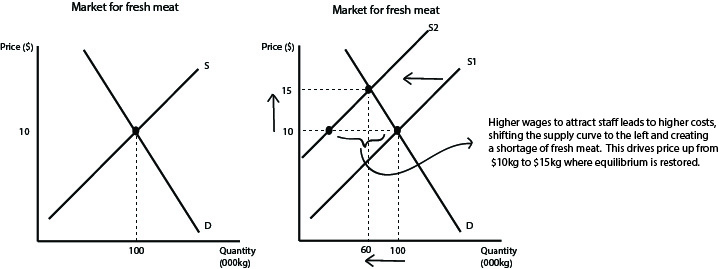Application Exercise 3j: Some COVID-19 impacts in 2022


- See diagrams above that relate to questions 1 and 2
- A shortage of workers will tend to both raise the costs of labour as businesses bid wages up in order to attract staff as well as restrict the ability of businesses to supply (produce) goods to the extent that they simply can’t secure staff. Either way, The supply curve will shift to the left, creating a shortage at the pre-existing price (in this case a shortage exists at $10 per kg) which leads to businesses raising the price in order to ration the goods and/or cover the costs of higher wages. The higher price of fresh meat will then result in a contraction of consumer demand (i.e. demand falls back along the demand curve) and the shortage will shrink until price rises to its new equilibrium point (at $15 in this hypothetical scenario.
- In the context of fresh meat, the law of demand dictates that an increase in the price of fresh meat will induce consumers to demand less meat and the reverse is true in the case of a decrease in the price of meat. The law of supply dictates that an increase in the price of fresh meat will induce producers to supply more to the market (and vice versa). A key difference between the two laws is that in the face of a price increase the law of demand results in lower output whereas the law of supply results in higher output.
- Staying away from work effectively reduces the supply of labour to labour markets, which ultimately exerts upward pressure on the price of labour as employers need to offer higher wages in order to attract staff.
- This measure will help to raise the supply of labour which exerts downward pressure on the price of labour (i.e. wages), helping to reduce the cost of production for businesses which can then be passed onto consumers in the form of lower (or discounted) prices.
- This will increase the price of labour relative to capital (e.g. machinery) and encourage businesses to substitute away from labour and towards greater investment in capital. It will therefore cause a reallocation of some labour resources away from productive pursuits to less productive pursuits (e.g. unemployment). It will also tend to reallocate resources away from the production of labour intensive goods towards capital intensive goods.
-
- A decline in consumer confidence would lead to a reduction in demand as consumers become more concerned about saving for uncertain times ahead. This would lead to lower prices and a lower quantity sold.
- Higher interest rates will also reduce demand as it becomes more expensive for households to repay existing debt. In addition, the higher cost of borrowing will reduce the willingness of consumers to undertake credit based consumption. This would also lead to lower prices and a lower quantity sold.
- Further lockdowns will not only restrict the ability of consumers to demand these types of services, it will also restrict the ability of producers to supply. This will have a large negative effect on the quantity sold in markets and an ambiguous effect on price given that only ‘black market’ activity will exist (Depending on the nature of the lockdowns)
- Further technological advances will ultimately help to increase productivity and improve supply conditions for businesses, Leading to lower prices and a higher quantity sold.
